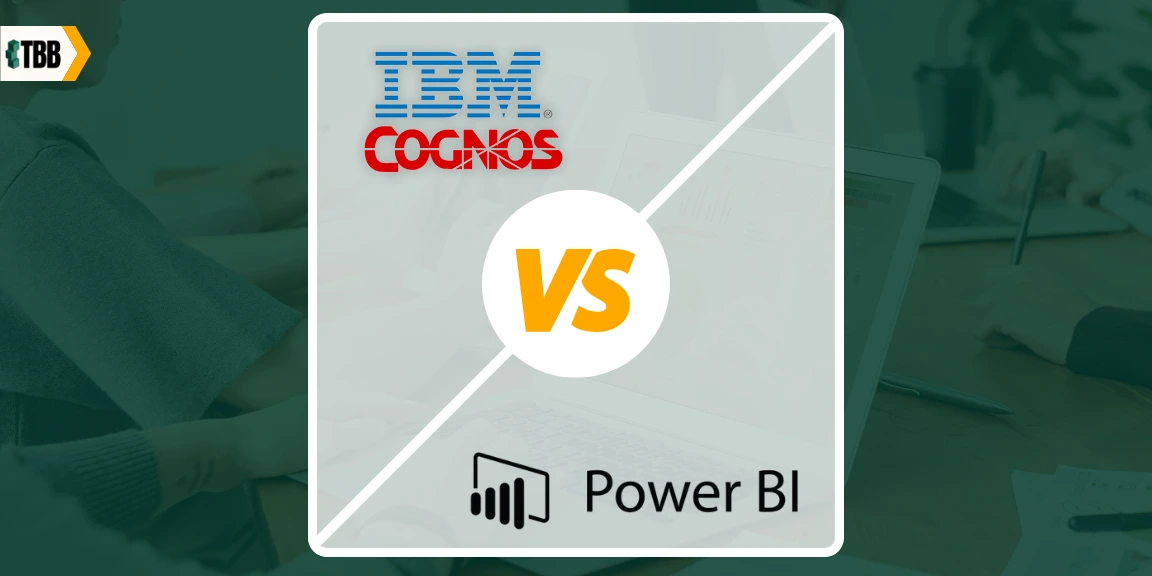IBM Cognos Analytics and Microsoft Power BI are the most popular BI and data analytics applications. Both apps are in high demand as firms strive to leverage the massive amounts of data produced daily.
A significant volume of data is submitted to data analytics, either from large datasets, social networks, database systems, or overloaded business systems. Instead of a small staff of business intelligence professionals gathering data, advertising, selling, and IT teams are now using analytics to discover the advantages of digital change.
Business intelligence software is already a must-have for companies looking to gain every possible strategic advantage.
Are you Confused about which Business Intelligence platform to choose for your Company’s data analysis needs?
If so, you might be considering Cognos and Microsoft Power BI. Both platforms offer comprehensive features that enable users to visualize and interpret their data meaningfully. However, each tool also has its own unique set of capabilities depending on the user’s specific needs.
Cognos is ideal for larger organizations as it can easily integrate with existing systems, making accessing all relevant data in one place easy. It offers a wide range of advanced reporting functions and sophisticated analytics applications that allow users to drill down into deeper insights quickly and accurately. On the other hand, Power BI is great for smaller companies looking for an easier-to-use solution at a lower cost since its cloud-based model does not require any complex installation procedures or additional IT infrastructure investments.
Read on and Compare both solutions today and decide which tool best suits your organization’s goals!
What is Cognos?
Cognos is an IBM business intelligence performance management application that enables professional and non-technical staff in any firm to analyze, obtain, and build interactive visualizations that help the Company to make crucial choices. The Cognos tool includes several systems that allow connectivity with various third parties.
The IBM Cognos platform includes self-service features and self-service analytical services that enable business users to engage with business information despite the absence of data analysis experience. In other wordsno other data-related knowledge is necessary with IBM Cognos’ self-service features with IBM Cognos’ self-service features with IBM Cognos’ self-service features.
The accessible findings aggregate data and produce consumer exploratory data graphs and graphics. Furthermore, self-service Business Intelligence lets users examine and display data without involving an IT staff.
What is Power BI?
Power BI is a business analytics tool that allows you to visualize data and provide insights throughout your organization and and integrate them into your application or website. The system consists of numerous goods and services, and the benefit and adaptability come from utilizing the different pieces and reaping the benefits of how they interact collectively.
Microsoft Power BI is often used to analyze and display perceptions based on a company’s data. Power BI can link to a wide variety of data sets and cleans up the information it receives so that it may be processed and comprehended more easily. The analysis and graphics created from this information may then be distributed to other users.
Similarities between the two platforms
- Category
While both are regarded as business intelligence tools, Cognos is further characterized as Integrated Business Intelligence software and Self-Service Business Analytics software. Besides the core category stated above, Power BI offers no further statements.
- Browser compatibility
Power BI and Cognos can be accessible via the web, which means mobile networks can also utilize themmobile networks can also utilize themmobile networks can also utilize them. Power BI now provides the capacity for mobile operating systems like Apple, Android, and Windows Mobile.
- Support for the cloud
Because Cognos and Power BI are cloud-based software systems, their data is conveniently available anywhere at any moment. However, only Cognos supports local data centers.
What makes one better than the other
Power BI can connect to lots of on-premise and cloud-based data sources. With its automatic progressive updates, you may access up-to-date data from Dynamics 365, inbound marketing, Microsoft Azure DB, Spreadsheet, and PowerPoint.
Data simulation models let you handle data more quickly. To swiftly modify, connect, and enrich your data, use the self-service Power Query with which many Excel users are acquainted.
IBM Cognos can link to various data sources, such as spreadsheets. It includes methods for automatically joining numerous data sources, resulting in more useful insights. An AI Companion tool speaks in plain English, allowing you to ask questions regarding your data and receive clear advice. To discover new interactions, use the Explore tool. Exploratory visualizations provide Automation findings in straightforward language.
Pros and Cons of Cognos
Pros:
- Using a variety of data sources.
- Alerts and scheduling.
- A simple and easy-to-use interface.
- Personalized encounter.
- Smart search is context-aware.
- Offline and online interactive data is provided.
- These advantages provide a compelling case for choosing IBM Cognos over alternative BI systems. IBM cognos connects to a variety of data sources and provides a comprehensive set of features.
Cons:
Along with the advantages of IBM Cognos Intelligence that are previously mentioned, there are also some disadvantages to be aware of. A complete overview is the best approach to determine whether this service benefits you.
- IBM’s expenditure on Cognos R&D is decreasing.
- The total cost of ownership (TCO) is greater than other tools.
- Forecasting powers are limited.
- IBM’s investment in Cognos R&D is dropping.
- It will not perform well with huge data sets with many variables.
- Cross-browser compatibility is frequently an issue.
Pros and Cons of Power BI
Pros:
- Affordable.
- Quick Updates.
- Data Availability.
- Individualized Visualizations.
- Integration with Excel.
- Interactive visualizations.
- Data Interconnectivity.
Cons:
- Users frequently complain about Power BI’s dense and complex user interface.
- Power BI is incapable of handling complicated interactions.
- Sometimes, your formulas work well in Power BI, and sometimes they don’t.
- Power BI does not give many possibilities for customizing visuals to meet your needs.
- Power BI is a collection of interconnected technologies you must learn and master in addition to Power BI.
Pricing difference
Power BI
- $9.99 per month/user
- Individual users may be licensed with current, self-service analytics, allowing them to explore data with live reports and dashboards and exchange ideas throughout the business.
Cognos
- $15 /User/Month
- $180.00 per user per year billed yearly
Tips for Choosing the Best Business Intelligence Platform
Data analytics platform selection can be a daunting task. Here are some tips to help you get started on the right foot:
1. Consider Your Business Goals – It’s important to have an understanding of your organization’s goals and objectives when selecting a business intelligence platform. This will help determine which features are essential and which ones are optional.
2. Evaluate Your Data – Company’she types of data you’ll be working with and how it needs to be processed is key when selecting a BI platform. For example, some platforms are better suited for structured data while others can handle unstructured data as well.
3. Analyze Your Resources – How much time and money do you have to invest in a business intelligence platform? Be sure to consider the cost of software, hardware, licensing fees, and maintenance when selecting a BI platform.
4. Understand Your Users – Make sure that the platform you select is user friendly for all users in your organization. Consider factors such as usability, training requirements, and security before making a decision.
5. Research Your Options – Take some time to evaluate the available options and read reviews from other users. Be sure to consider both the benefits and drawbacks of each platform before you make a final decision.
By following these tips, you can help ensure that you’re selecting the right business intelligence platform for your organization. Business analytics tools are essential for gaining insights into your data and making informed decisions. With the right platform in place, you can easily uncover hidden patterns and trends in your data that will help you make better business decisions and drive growth. So take the time to do your research and pick the best BI platform for your needs! Good luck!
Frequently Asked Questions About Cognos vs. Power BI
Q: Does Cognos and Power Bi tool have a geospatial mapping power?
A: Yes, both Cognos and Power BI have a geospatial mapping power. This allows you to easily visualize and analyze data on a map and analyze geographical patterns that can help identify new opportunities or areas of focus.
Q: Is one platform better than the other for assessing customer feedback?
A: Both Cognos and Power BI offer powerful analytics and reporting capabilities to help you analyze customer feedback. However, Power BI has an advantage when it comes to interactive visualizations as its drag-and-drop interface makes it easier for users to create powerful visuals with their data.
Q: Does either platform offer advanced data science techniques?
A: Yes, both platforms offer advanced data and science techniques. Cognos has a wide range of predictive analytics options while Power BI includes machine learning capabilities to help you uncover insights from your data.
Q: Do I need to hire a specialist to use either platform?
A: No, you do not need to hire a specialist to use either platform. Both platforms are designed for business users and offer an intuitive interface with drag-and-drop features that make it easy to explore and analyze your data.
Q: Can data discovery, streaming analytics and power bi reports server be used together?
A: Yes, data discovery, streaming analytics and Power BI Reports Server can be used together to create a comprehensive business intelligence solution.
Conclusion
Business intelligence software is already a must-have for companies looking to gain every possible strategic advantage. If you want to join the increasing population of BI software users, you won’t be disappointed with Cognos or Power BI. However, consider your company’s limits consider your company’s limits consider your company’s limits before deciding which software to utilize.
Although nothing surpasses free (Microsoft’s Power BI desktop), using the additional Power BI capabilities takes at least the Power BI Pro edition. On the other hand, IBM’s Cognos provides a 30-day trial that allows you to determine whether the product suits your needs.
Considering how urgent your analytical needs are and how detailed your standards are, you might opt to go through Power BI, which is less expensive, quicker to migrate if you’re an Office customer, and integrates with existing apps. However, if you’re intent on going deep with analytics, you might want to try out Cognos for free to evaluate what Microsoft lacks before committing deeper.

